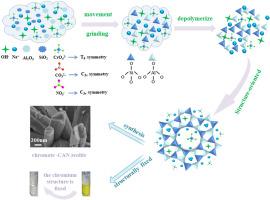煤气化炉渣固相合成 CAN 沸石的结构引导机理及其固定废水中 Cr6+ 结构的研究
IF 4.8
3区 材料科学
Q1 CHEMISTRY, APPLIED
引用次数: 0
摘要
大量煤气化粗渣(CGCS)的产生制约了现代煤化工的可持续发展。本文以煤气化粗渣为原料,采用固相合成法,节约水资源,是一种低二次污染的沸石合成新方法。采用不同类型的阴离子诱导合成沸石。利用 XRD、FT-IR、27Al-NMR、29Si-NMR、BET、SEM 和实验研究方法,研究了 CGCS 在固相反应中的活化和解聚以及阴离子对晶体生长的引导作用。结果表明,具有三重旋转轴对称性的阴离子结构可诱导合成单相 CAN 沸石。利用这一规律,以 CGCS 为原料,以具有三重旋转轴对称性的含 Cr6+ 废水为结构引导剂,合成了 CAN 沸石,并对废水中的 Cr6+ 进行了结构固定。结果表明,与 CGCS 对 Cr6+ 的吸附效果相比,合成的 CAN 沸石能有效固定废水中的 Cr6+(74.98 mg/g),远高于 CGCS(24.85 mg/g)。本文章由计算机程序翻译,如有差异,请以英文原文为准。

Study of the structure guide mechanism of solid phase synthesis of CAN zeolite from coal gasification slag and its fixation of the Cr6+ structure in wastewater
The generation of a large amount of coal gasification coarse slag (CGCS) restricts the sustainable development of the modern coal chemical industry. This paper uses CGCS as raw material, adopts a solid phase synthesis method, saves water resources, is a new method of synthesizing zeolite with low secondary pollution. Different types of anions were used to induce the synthesis of zeolites. Using XRD, FT-IR, 27Al-NMR, 29Si-NMR, BET, SEM, and experimental research methods, the activation and depolymerization of CGCS in the solid phase reaction and the guiding role of anions in crystal growth were studied. The results revealed that the anionic structure with triple rotational axis symmetry can induce the synthesis of single-phase CAN zeolite. Using this rule, CAN zeolite was synthesized using CGCS as raw material and Cr6+ containing wastewater with triple rotation axis symmetry as the structural guide agent, and Cr6+ in wastewater was structurally fixed. Compared to the adsorption effect of CGCS on Cr6+, the results showed that the synthesized CAN zeolite was found to effectively fix Cr6+ (74.98 mg/g) from wastewater, which was much higher than that of CGCS (24.85 mg/g).
求助全文
通过发布文献求助,成功后即可免费获取论文全文。
去求助
来源期刊

Microporous and Mesoporous Materials
化学-材料科学:综合
CiteScore
10.70
自引率
5.80%
发文量
649
审稿时长
26 days
期刊介绍:
Microporous and Mesoporous Materials covers novel and significant aspects of porous solids classified as either microporous (pore size up to 2 nm) or mesoporous (pore size 2 to 50 nm). The porosity should have a specific impact on the material properties or application. Typical examples are zeolites and zeolite-like materials, pillared materials, clathrasils and clathrates, carbon molecular sieves, ordered mesoporous materials, organic/inorganic porous hybrid materials, or porous metal oxides. Both natural and synthetic porous materials are within the scope of the journal.
Topics which are particularly of interest include:
All aspects of natural microporous and mesoporous solids
The synthesis of crystalline or amorphous porous materials
The physico-chemical characterization of microporous and mesoporous solids, especially spectroscopic and microscopic
The modification of microporous and mesoporous solids, for example by ion exchange or solid-state reactions
All topics related to diffusion of mobile species in the pores of microporous and mesoporous materials
Adsorption (and other separation techniques) using microporous or mesoporous adsorbents
Catalysis by microporous and mesoporous materials
Host/guest interactions
Theoretical chemistry and modelling of host/guest interactions
All topics related to the application of microporous and mesoporous materials in industrial catalysis, separation technology, environmental protection, electrochemistry, membranes, sensors, optical devices, etc.
 求助内容:
求助内容: 应助结果提醒方式:
应助结果提醒方式:


